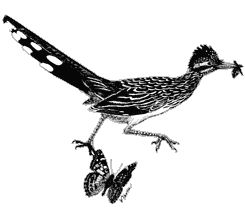Greater Roadrunner
The most famous bird in the Sonoran Desert, without a doubt, the Roadrunner is also the most fictionalized in popular imagination. Cowboys used to tell tall tales about how Roadrunners would seek out rattlesnakes to pick fights, or would find sleeping rattlers and build fences of cactus joints around them. A later generation of Americans grew up thinking that Roadrunners were purple and cried “beep beep” as they sped about.
 |
Even without such stretches or inventions, the real Roadrunner is impressive. Running in the open (and not just on roads), it reaches fifteen miles per hour. It can fly, but usually doesn’t. Often it seems curiously unafraid of humans. Trotting up close to peer at us, raising and lowering its mop of a shaggy crest, flipping its long tail about expressively, it looks undeniably zany. It comes as no surprise to learn that the Roadrunner is a member of the cuckoo family. |
Clownlike it may appear to human eyes, but the Roadrunner is a very effective predator. Its speed on foot is not just for show: it captures not only snakes and large insects, but also fast-running lizards, rodents, and various small birds. Gambel’s Quail may pay scant attention to the Roadrunner at most seasons, but they react to it violently when they have small young, and with good reason: given an opportunity, the Roadrunner will streak in to grab a bite-sized baby quail.
—Kenn KaufmanGreater Roadrunner (Geococcyx californianus)
Order: Cuculiformes
Family: Cuculidae (Cuckoos)
Spanish Names: correcaminos, churea, paisano
Distinguishing features
Our largest cuckoo, this bird is characterized by a long tail, streaked appearance, frequently erected shaggy crest, and a blue and orange bare patch of skin behind the eyes. It is capable of running very rapidly across the ground (15 mph) and rarely flies. Like all cuckoos, the Roadrunner is a zygodactyl bird (it has 2 toes pointing forward and 2 toes backward).
Click to hear Roadrunner foraging sounds
Click to hear Roadrunner clucking sounds
Habitat
The Roadrunner prefers open country, desert, open pinon/juniper habitat.
Feeding
• Diet: Feeds upon any animal small enough for it to kill and ingest, including small birds and snakes; young are fed insects, lizards, and mice; also eats some fruits and seeds.
• Behavior: Hunts by walking briskly and running toward prey once it is located; also able to jump straight up in the air when small birds or flying insects are overhead. The adult uses its long tail as a rudder for maneuvering while running.
Life History
The pair bond in this species may be permanent; pairs are territorial all year. Courtship displays include, but are not limited to, presenting the mate with a twig or piece of grass and chasing one another.
The nest, which is constructed of twigs, is frequently found in cholla, mesquite, or palo verde. White eggs (3 to 6) are laid at intervals; if food is scarce the older, larger hatchlings will quickly seize all the food from the parents thus causing the younger, smaller ones to starve. Rarely do all nestlings reach maturity. If not enough food is available, these younger birds will be fed to the other, stronger hatchlings.
Roadrunner skin is heavily pigmented. On cool mornings, the bird positions itself with its back towards the sun and erects its feathers, thus allowing the sun to strike directly on the black skin which quickly absorbs heat energy. This makes it possible for the bird to achieve body heating without unnecessary expenditure of metabolic energy.










